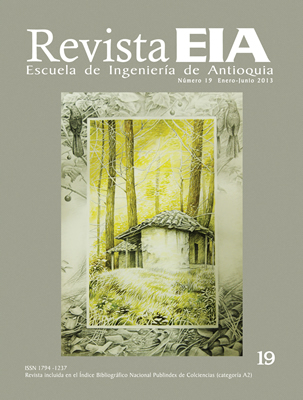CONTROL DE Fasciola hepatica EN EL AGUA DE CONSUMO ANIMAL A TRAVÉS DE FILTRACIÓN RÁPIDA Y LENTA (CONTROL OF Fasciola hepatica IN ANIMAL DRINKING WATER BY FAST AND SLOW FILTRATION)
CONTROL DE Fasciola hepatica EN EL AGUA DE CONSUMO ANIMAL A TRAVÉS DE FILTRACIÓN RÁPIDA Y LENTA (CONTROL OF Fasciola hepatica IN ANIMAL DRINKING WATER BY FAST AND SLOW FILTRATION)


This work is licensed under a Creative Commons Attribution-NonCommercial-NoDerivatives 4.0 International License.
Copyright statement
The authors exclusively assign to the Universidad EIA, with the power to assign to third parties, all the exploitation rights that derive from the works that are accepted for publication in the Revista EIA, as well as in any product derived from it and, in in particular, those of reproduction, distribution, public communication (including interactive making available) and transformation (including adaptation, modification and, where appropriate, translation), for all types of exploitation (by way of example and not limitation : in paper, electronic, online, computer or audiovisual format, as well as in any other format, even for promotional or advertising purposes and / or for the production of derivative products), for a worldwide territorial scope and for the entire duration of the rights provided for in the current published text of the Intellectual Property Law. This assignment will be made by the authors without the right to any type of remuneration or compensation.
Consequently, the author may not publish or disseminate the works that are selected for publication in the Revista EIA, neither totally nor partially, nor authorize their publication to third parties, without the prior express authorization, requested and granted in writing, from the Univeridad EIA.
Show authors biography
La fasciolosis bovina es una zoonosis causada por Fasciola hepatica, parásito que se adquiere al consumir agua o vegetales contaminados con el digeneo. Esta enfermedad ocasiona pérdidas económicas importantes en las regiones lecheras de Antioquia. En este trabajo, y con el objetivo de remover los huevos del parásito presentes en el agua, se diseñaron y construyeron dos filtros empleando como lecho filtrante arena industrial (T.E entre 0,45 y 0,55 mm), con los cuales se evaluó un sistema de filtración rápida operado a velocidades de 5 y 8 m/h (altura del lecho 60 cm) y un sistema de filtración lenta a una velocidad de 1,46 m/h (alturas del lecho 30 y 40 cm). Se determinó la variación del caudal y la turbiedad del efluente durante la carrera de filtración y la eficiencia de remoción de los huevos del parásito. Los filtros operando bajo las características descritas, fueron 100% eficientes para remover los huevos de F. hepatica presentes en el agua. Los porcentajes de remoción de turbiedad fueron del 85,5 y 79,4% para filtros trabajando a velocidades de 5 m/h y 8 m/h, respectivamente. Los ensayos realizados para ambas alturas del lecho filtrante (30 y 40 cm) operando con la velocidad de 1,46 m/h, mostraron una remoción promedio de turbiedad del 80,4 y 76,6%, respectivamente.
Abstract: The bovine fasciolosis is a zoonosis caused by Fasciola hepatica transmitted by consuming water and / or vegetables contaminated with the digenea. This disease causes significant economic losses in the dairy producer regions of Antioquia. In order to remove the eggs of the parasite from water, we designed and built two filters (rapid and slow filtration), using industrial sand as filter bed (effective size 0.45-0.55 mm). A rapid filtration system was evaluated at speeds of 5 and 8 m/h for a sand bed height of 60 cm and a slow filtration system at a speed of 1.46 m/h for sand bed heights of 30 and 40 cm. The variation of effluent flow and removal efficiency of both turbidity and parasite eggs were determined during the run of each filtration. The results show that all filters operating under the described features are 100% efficient in removing the F. hepatica eggs from the water. The turbidity removal percentages were 85.5% and 79.4% for filters operating at speeds of 5 m/h and 8 m/h respectively. The tests performed for bed heights (40 and 30 cm), operating at 1.46 m/h, showed average turbidity removals of 80.4% and 76.6% respectively.
Sumário: A fasciolosis bovina é uma zoonose causada por Fasciola hepatica, parasita que se adquire ao consumir água ou vegetais contaminados com o digeneo. Esta doença ocasiona perdas económicas importantes nas regiões lecheras de Antioquia. Neste trabalho, e com o objectivo de remover os ovos dos parasita presentes no água, desenharam-se e construíram dois filtros empregando como leito filtrante areia industrial (T.E entre 0,45 e 0,55 mm), com os quais se avaliou um sistema de filtración rápida operado a velocidades de 5 e 8 m/h (altura do leito 60 cm) e um sistema de filtración lenta a uma velocidade de 1,46 m/h (alturas do leito 30 e 40 cm). Determinouse a variação do volume e a turbiedad do efluente durante a carreira de filtración e a eficiência de remoción dos ovos do parasita. Os filtros operando baixo as características descritas, foram 100% eficientes para remover os ovos de F. hepatica presentes no água. As percentagens de remoción de turbiedad foram de 85,5 e 79,4% para filtros trabalhando a velocidades de 5 m/h e 8 m/h, respectivamente. Os ensaios realizados para ambas alturas do leito filtrante (30 e 40 cm) operando com a velocidade de 1,46 m/h, mostraram uma remoción.
Article visits 404 | PDF visits 183
